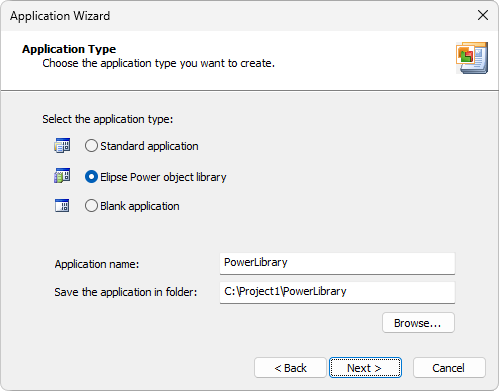ElipseX objects may contain, in addition to drawings, internal variables that can be exported to an application, and programming logic, or scripts, that is present in all copies of this developing object, thus diminishing the need for repeating code in several parts of an application. To create a new library in Elipse Power, follow these procedures:
1.Go to File menu, select the New Project item, and then click Next.
2.In the Select the application type option, select the Elipse Power object library item.

Application Wizard
3.Type a name for this library and click Next.
4.Configure all specifications regarding its Domain.
5.Click Finish.
In an ElipseX library, users can insert XControls, XFolders, and XObjects objects.
All items available for Screens can be inserted in XControls. Among these items are primitive drawings, graphical vector objects, including symbol library objects, such as files in WMF and EMF format, among others, graphical non-vector objects, such as files in BMP, JPEG, and GIF format, among others, Elipse Power ActiveX controls, such as E3Charts, E3Browsers, and E3Alarms, third-party ActiveX controls, and other XControls.
An XFolder is an object that allows inserting child objects in its instances. Therefore, users can organize or create hierarchies of objects in an application. Users can insert in an XFolder items such as Data Folders, I/O Tags, Alarm Filters, and XFolder instances, among others.
XObjects can contain any type of non-graphical objects, which are executed in an E3 Server. Users can insert in an XObject the objects I/O Drivers, I/O Tags, Data Servers, Databases, Formulas, Alarm Configurations, Alarm Servers, COM objects, and other XObjects.
In the same library file, users can have any number of ElipseX components, whether they are XControls, XFolders, or XObjects. Users can also have many different libraries, or several library files, in the same Domain.